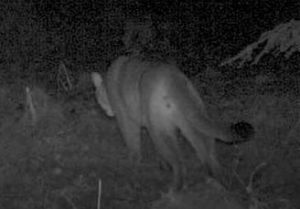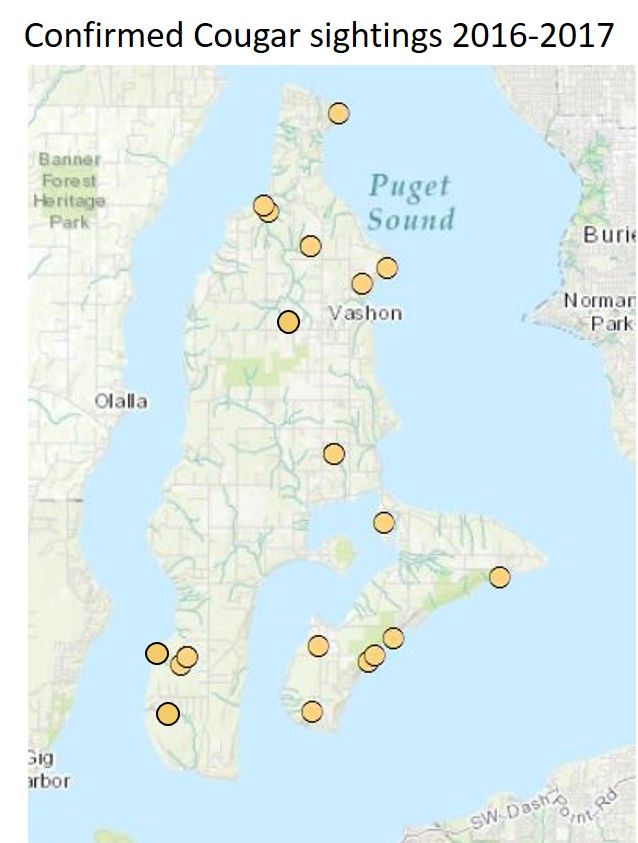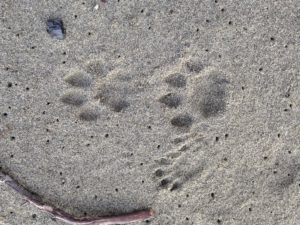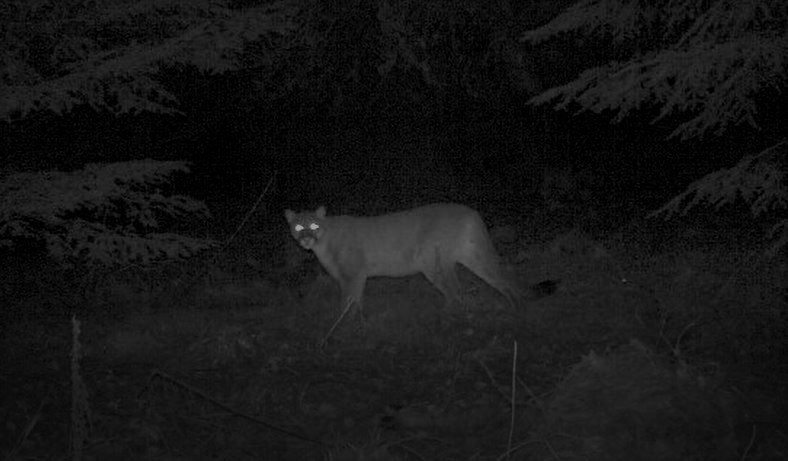by: Kathryn True
A mountain lion has made its home on Vashon since last July. Its presence inspires awe, joy, fear, excitement, and fuels rumors. At Vashon Nature Center, we hear many questions and concerns about the cougar. We came up with a list of the most commonly held misconceptions and asked Dr. Brian Kertson, cougar expert and wildlife research scientist with the Washington Department of Fish and Wildlife (WDFW), to address them.
For more information, see Vashon Nature Center’s Living with Wildlife pages and our Coexisting with Large Predators fact sheet, or WDFW’s Living with Wildlife Cougar pages.
Vashon Nature Center is a research and education center. We field questions about living with wildlife and collect wildlife sightings as part of the island’s natural history record, but we do not manage wildlife. Questions or issues pertaining to cougar management should be referred to WDFW.
Myth #1: Vashon-Maury is not cougar habitat.
Brian Kertson: The big driver in that equation is that there are both deer and relatively large chunks of unbroken forest on Vashon. Those two factors alone make it cougar habitat. Mountain lion habitat needs in western Washington are not particularly complicated—they need cover and prey (mainly deer)—and island forests provide a lot of both. The residential density on Vashon is low enough that development modifies the habitat, but doesn’t make it unsuitable.

This screenshot taken from VNC’s wildlife camera network was the first confirmation that our cougar is a male. The small black dot revealed when his tail flips to the side is the indicator! Learn more about sexing and aging a cougar.
Another thing I have heard is that cougars don’t belong on islands, but the reality is that cougars swim open water all the time—across lakes and rivers—and they routinely travel island-to-island and mainland-to-island. (The cougar currently living on Vashon-Maury likely swam over from the Kitsap Peninsula on a minus tide. There is a viable, consistent cougar population on Kitsap. Most likely this cat was a subadult male that dispersed from natal territory, which they typically do when they are 18 months old.)
There is a difference between what people perceive as habitat and what cougars perceive as habitat. He’s been there for at least nine months, and if it wasn’t cougar habitat, he would have left by now. He appears to be finding what he needs to survive.
Myth #2: There have never been cougars here and they shouldn’t be here now.
KT: Vashon Nature Center has researched historical records of island cougars: They were photographed and noted in news records on the island several years from 1915 thru 1924. More recently, cougar sightings were reported in 2011, 2015, 2016, and 2017.
Myth #3: There must be two cougars because they have been reported on opposite ends of the island from one day to the next.
Brian Kertson: Cougars can easily travel 10 to 12 miles in a single day. It would not take very long for the cat to traverse the island.

This map shows only sightings that have been confirmed by photo or track/sign from June 2016 through May 2017. During this time VNC has also received 120 sightings reports but it is impossible to verify word-of-mouth sightings (scientific research done on sightings reports indicates that as many as 75% of word of mouth sightings are mistaken!) Timing data from our wildlife camera network shows that this cougar has moved from one end of the island to the other in as little as a day or as long as 16 days (movements are likely dictated by the cat’s hunting success). Map created by: B Perla from VNC wildlife sightings database.
Myth #4: It’s easy to protect livestock in the presence of large predators.
Brian Kertson: I recognize it can be both difficult and inconvenient to round up animals and board them every night—there is time and energy involved, and better fences cost money. Persistence is important to consistently reduce the risk to your animals. But that’s the reality when you live in a landscape where large carnivores are present; you have to behave differently.
The overwhelming majority of cougar attacks on livestock occur at night. If you board animals at night, you drastically reduce your animals’ chances of being attacked by a cougar. It’s also important to have good fences that deter carnivores from pursuing livestock and keep them from being in a situation where they are more likely to be attacked. Other effective deterrents are guard dogs, good lighting, and electric fencing.
KT: State investigations of depredations on the island (including use of dogs to track cougar scent at kills) indicate that coyotes or domestic dogs are frequently responsible for livestock deaths initially attributed to cougar. Since last summer, three alpacas, and one sheep have been confirmed as cougar depredations—four other sheep are considered possible but unknown due to lack of evidence. Vashon Nature Center staff recognize the high emotional toll these deaths take on their owners and the community. This makes it essential that we support each other in sharing what we learn as we make changes to adapt to the presence of wild predators. As part of this effort, VNC is creating a local resource directory of people who have had success protecting their animals and are willing to share their experiences and lessons learned. Let us know if you have ideas of other ways we can help each other.

VNC staff and volunteers enjoyed following the cougar’s tracks for almost one mile down the beach last fall. Our cougar’s tracks are just a tad smaller than average indicating that this male is likely young. Raccoon tracks can also be seen here. photo by: Bob Lane
Myth #5: There’s something wrong with this cougar because it keeps being seen.
Brian Kertson: Vashon is not a huge island and the human population is sufficiently large enough that the chances for any one person seeing the cat on any given day are probably a lot greater than people realize. Simply seeing it is not abnormal at all; they are very active during the day. It would be abnormal if the cougar was going into people’s garages or walking down the middle of a well-traveled road. But seeing it on edges of property or running across the road in the late afternoon or early morning … that’s just being in right place at the right time. Somebody’s going to see it here and there. WDFW routinely receives reports of cougar sightings throughout the state in situations very much like Vashon in terms of residential development patterns and human population size. Sightings might be unsettling for some residents, but there is nothing abnormal about it.
Myth #6: Our livestock are getting killed, our children are next.
Brian Kertson: From a behavioral standpoint, humans and livestock represent completely different search images for a cougar. Just like black-tailed deer, the cougar’s primary prey, hooved livestock walk on four legs and eat grass—many species of livestock fit the search image of what a cougar is looking for. Human beings stand upright, walk on two legs, vocalize differently than livestock, and smell very different—we don’t fit the search image of cougar prey. In last 125 years, there have been 18 documented attacks of cougars on people in Washington state. Consequently, the likelihood of encountering a cougar is very low and the odds of being attacked by a cougar are exceptionally low. Educating yourself and your kids on what to do in the event a cougar is encountered is critical to both your welfare and the welfare of the cougar.
Myth #7: If I encounter a cougar, there’s nothing I can do.
Brian Kertson: If you do happen to encounter a cougar, there are things you can do that will greatly reduce the risk of being attacked. Stop, stand tall, and do not run. Maintain eye contact with the cougar, yell, wave your arms, and make yourself as big and intimidating as possible. By doing those things you are very unlikely to be attacked. If you are attacked, fight back as vigorously as best you can—you are likely to be injured, but also more likely to survive.
Myth #8: Now I can’t run or recreate like I used to in island forests.
Brian Kertson: You can absolutely still recreate. Do you have to make some minor modifications? Yes. First and foremost, be mentally prepared. While running or mountain biking you have to recalibrate what is and isn’t possible. Make lots of noise to avoid surprising a cougar. If you are really concerned, carry bear spray (available at outdoor stores for about $40). There is a greater risk of encountering a cougar early in the morning or late in the afternoon—dawn and dusk—but this doesn’t mean that you have to avoid doing things outdoors at these times. More than anything, it’s about being aware.
Myth #9: We wouldn’t have this problem if the state would remove this cougar.
Brian Kertson: Just to be clear, “removing” the cougar would take one of two forms; relocation or, more likely, euthanizing the animal. The decision of whether or not to remove the cat, and how, lies with WDFW’s local enforcement officers. They are monitoring the situation and if they believe removing the cat is warranted, they will remove the cat. Both options require locating and capturing the cougar, and that is easier said than done. Vashon is not a large island, but there are still a lot of places for the cougar to hide or go undetected. Additionally, WDFW does not have personnel stationed on Vashon, so any capture attempt would require circumstances that ensure the cougar would still be on-site when a team arrives. Unless those circumstances present themselves, removing the cougar is not an option.
Regardless of whether WDFW removes this cougar, Vashon’s residents need to recognize their island is home to a variety of carnivores, and living with these species requires that people adjust their behavior accordingly.
Myth #10: We’d be a lot better off without this cougar.
Brian Kertson: I cannot speak to what people value and whether they think having a cougar present on Vashon makes it better or worse off. However, I can speak to the ecological ramifications of having cougar present because the science is pretty definitive. Ecosystems where top-tier predators are present are more resilient, maintain greater biodiversity, function completely, and frequently provide more ecosystem services for people. When apex predators are absent, herbivores like black-tailed deer can become overly abundant. Overly abundant deer populations can reduce the diversity and abundance of herbaceous plants leading to the elimination of species that rely on those plants. In short, you get a system that becomes more homogenous, deer-heavy, and incomplete. In that situation, you can lose songbirds, invertebrates, and small mammals that depend on the plants that the deer have been ravaging.
Beyond biodiversity and ecosystem function, the cougar’s presence may reduce the deer population— that’s fewer deer that could potentially be hit by a car. As funny as it seems, the cougar might even improve public safety by reducing the risk of automobile collisions with deer on the island.
KT: Thank you to Brian Kertson for taking the time to answer our questions and bust some myths.
Featured photo of the cat at top is from a VNC wildlife camera on Vashon, BPerla. Learn more about our wildcam network.


Thanks so much, for this! I really appreciate all the work that everyone at Vashon Nature Center does for our beautiful island.
This information can assist us in living in harmony with the natural world.
Linda
Thanks for the kind words Linda. Feel free to pass along information to neighbors and friends. I agree, the more we know about island wildlife the more tools we have to live among our wild neighbors with more joy and less conflict.
Great information. I personally believe we are much better off with the cougar than without for all the reasons mentioned. I am also a farmee with over 140 goats and I believe in protecting my livestock with excellent fencing, and guardian dogs. I for one want to live side by side the wildlife that makes Vashon their home. I believe in predator friendly farming.
Thanks for your comment, Tammy! I hope others will be able to draw on your expertise as it is so helpful to see local examples of how to protect livestock successfully.
Thank you for the great information. You answered questions I hadn’t even thought of yet. I wonder if our cougar will leave us when he gets ready to find a mate?
Thanks for writing, Holly. That is a good question. I think there are many variables that make this hard to answer, including this animal being a unique individual with his own reasons for staying or leaving that we will never understand. I so wish we could ask him!
This was wonderful. Thank you so very much. Reading When Mountain Lions Are Neighbors. Beautiful book. Blessings to you. Jamie Wolf
Thanks for your note, Jamie! That is a great book–lots of great examples for how to successfully coexist with all kinds of wild neighbors. What about that fox story!?